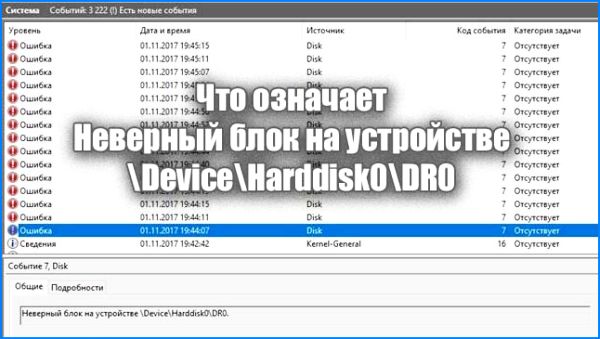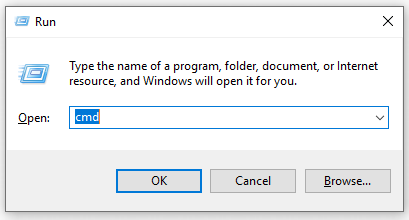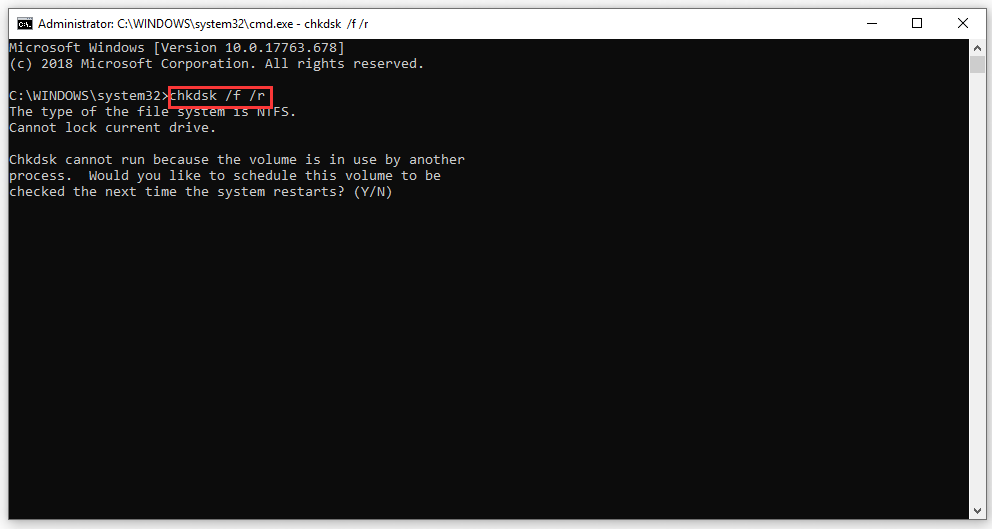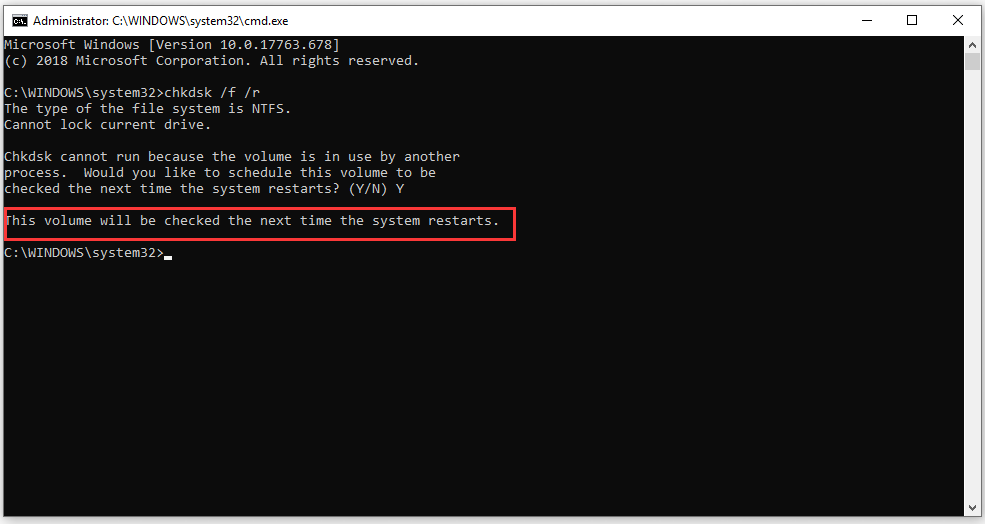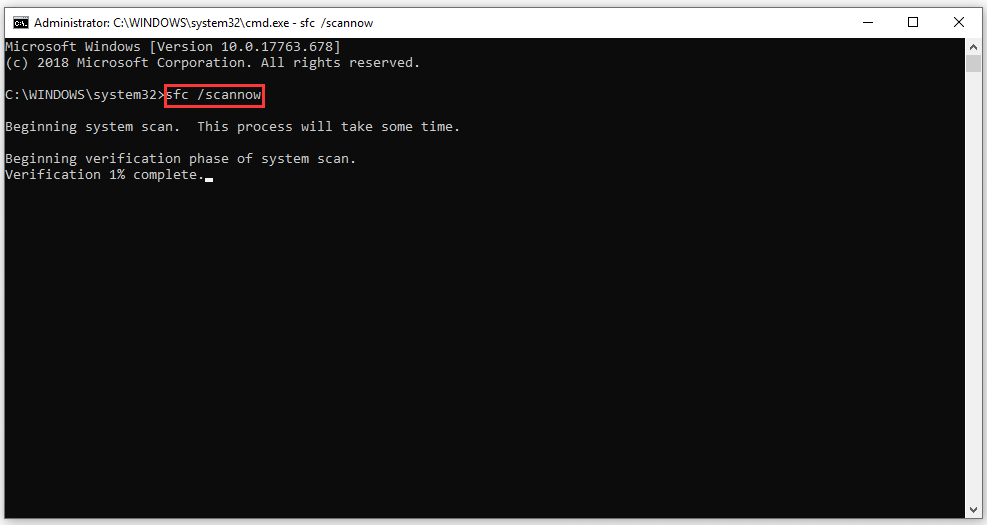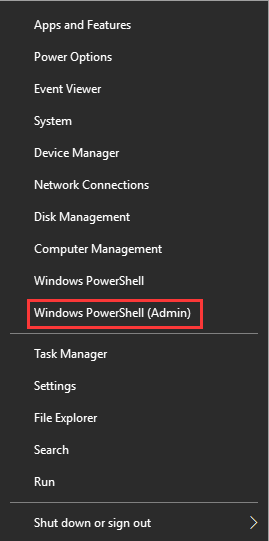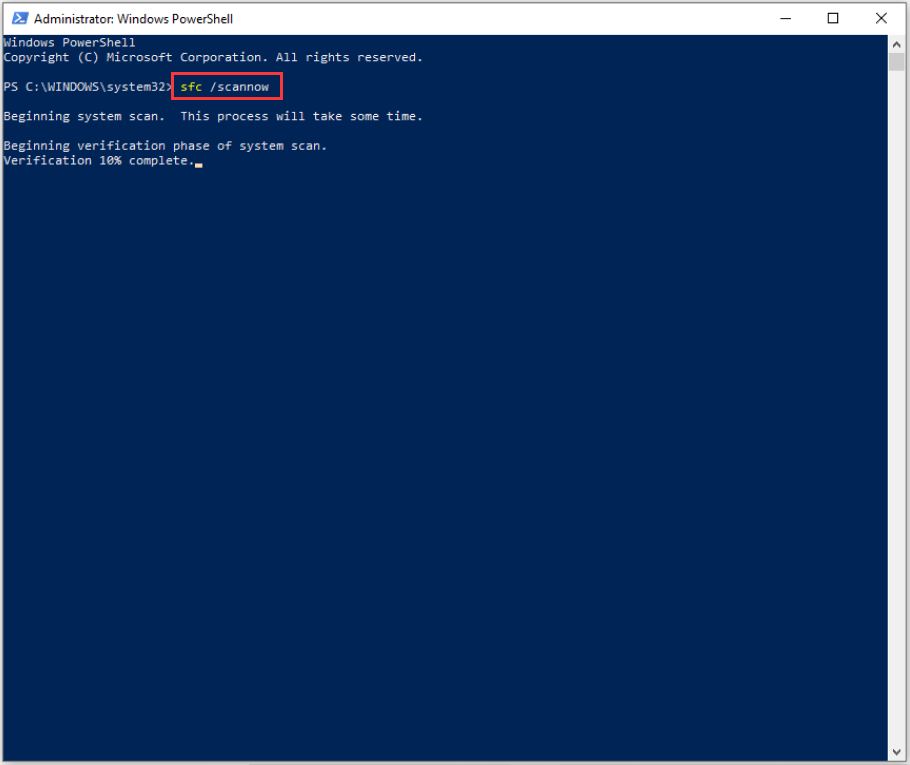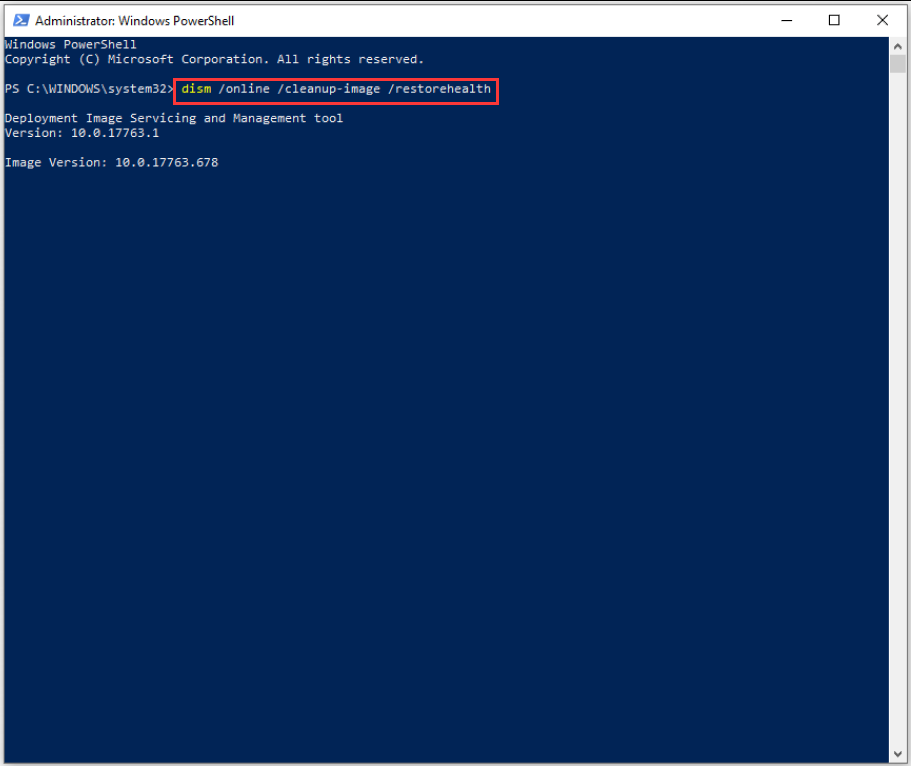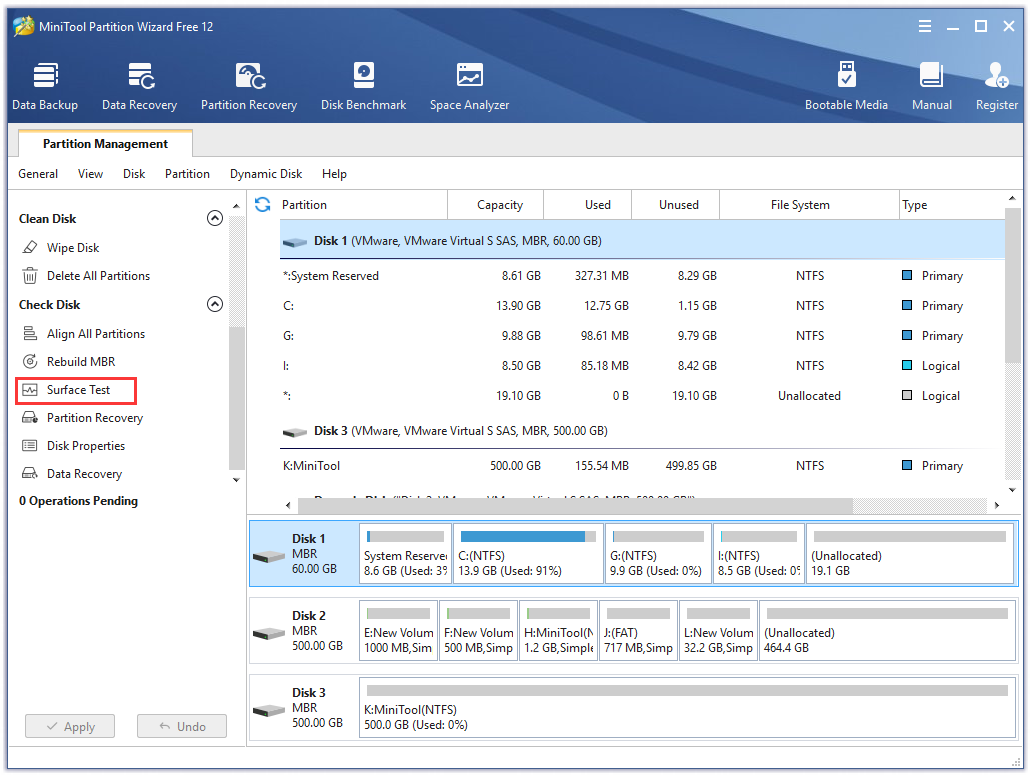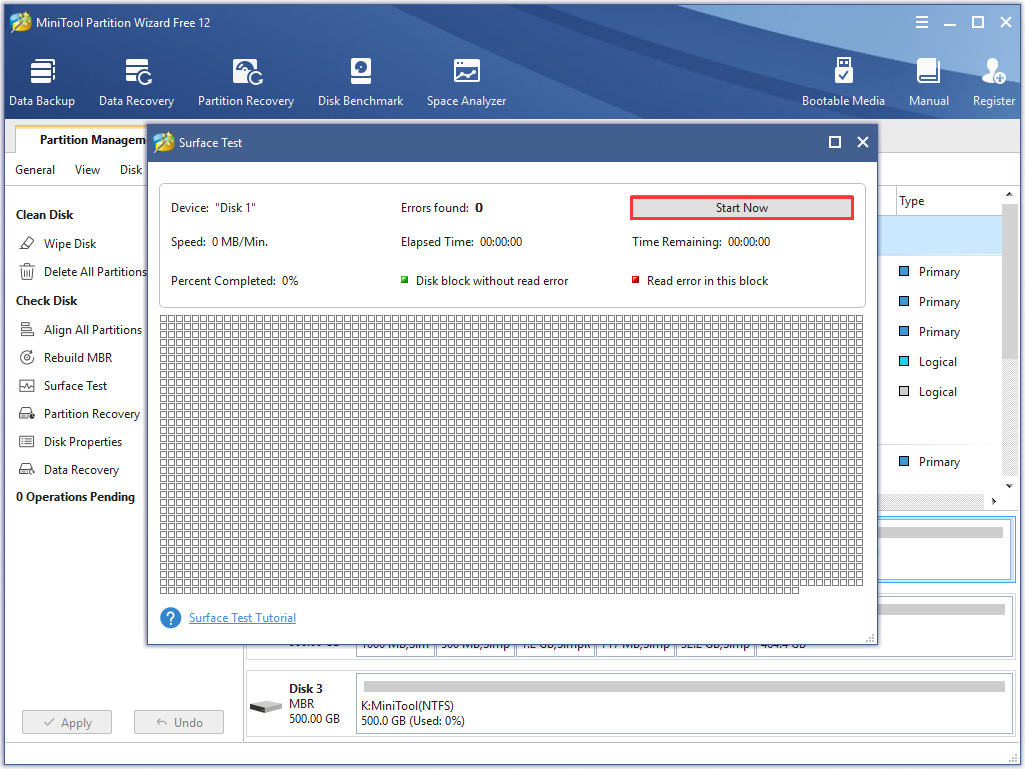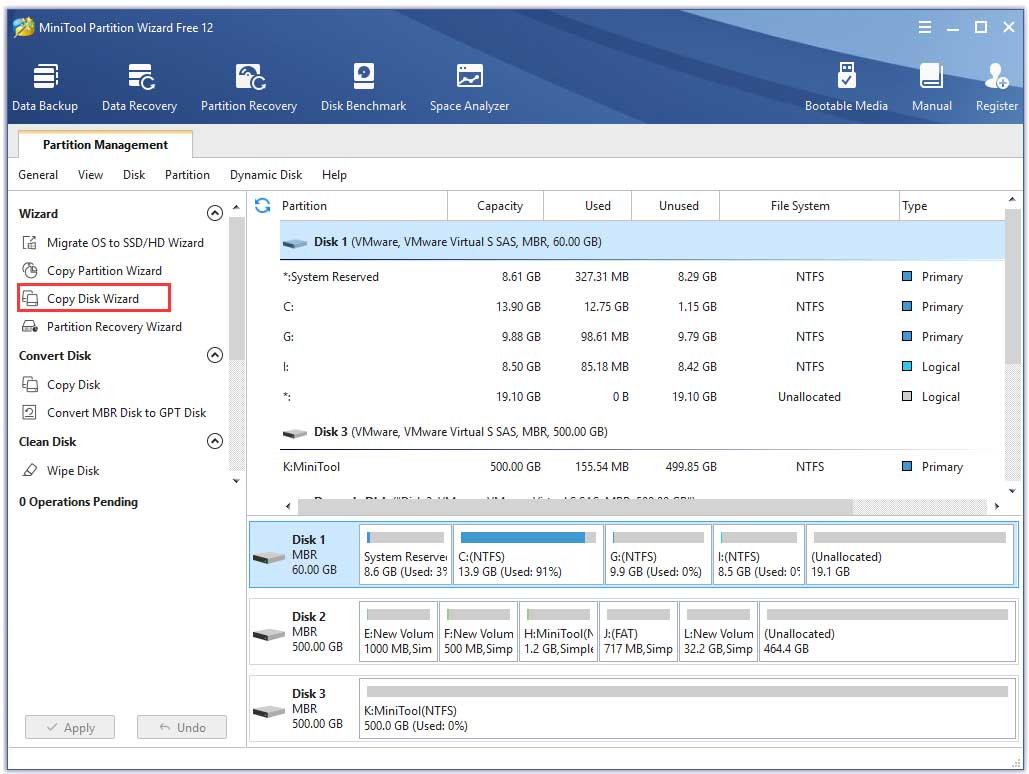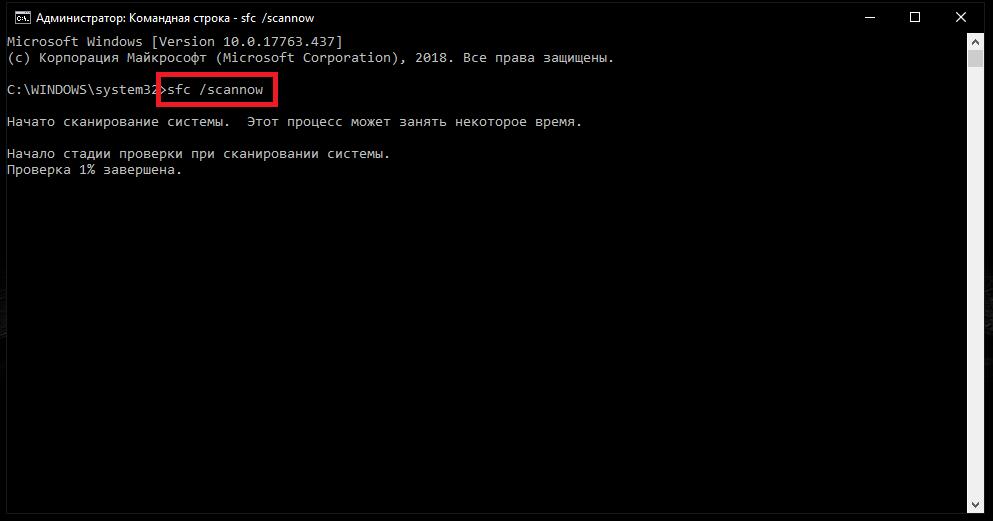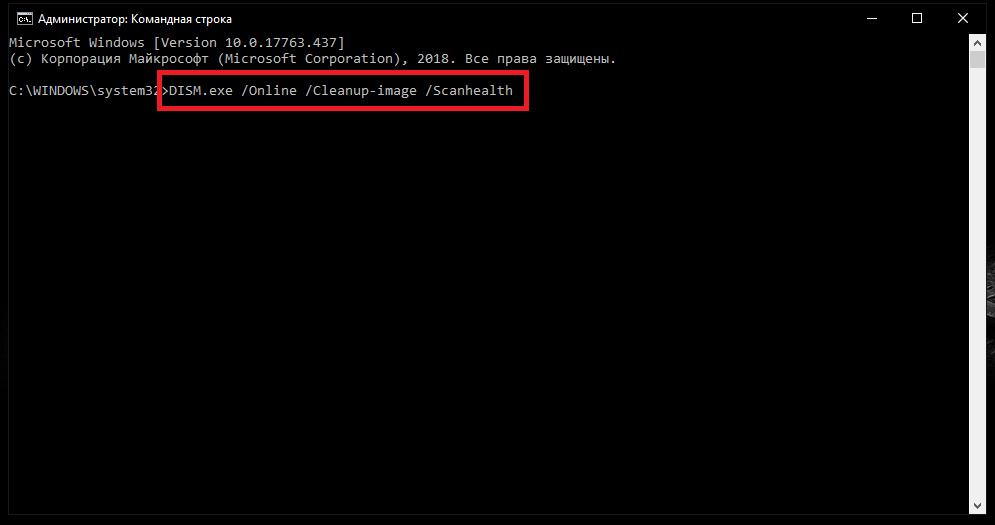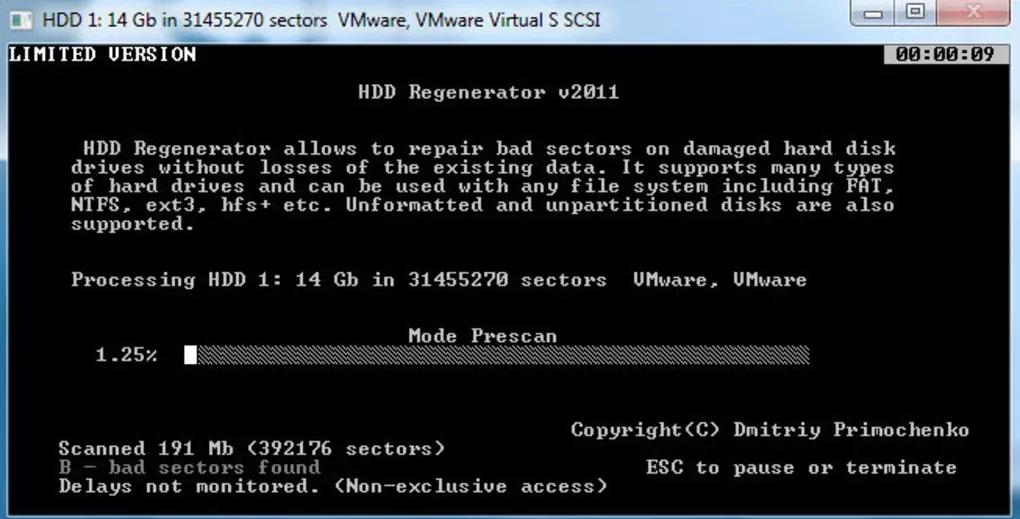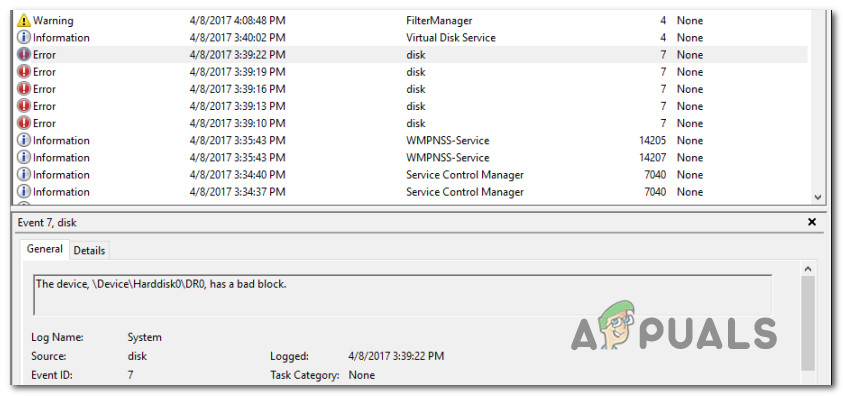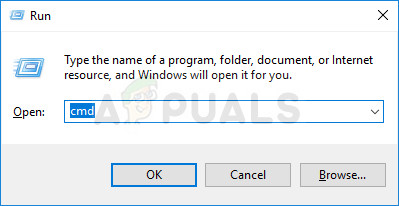При просмотре журнала событий иногда можно столкнуться с записями «неверный блок на устройстве device harddisk0 dr0». При их постоянном появлении также можем заметить снижение производительности системы.
Содержание
- 1 Что вызывает ошибку в дисковом устройстве
- 2 Способ 1: Сканирования CHKDSK
- 3 Способ 2: Проверка файловой системы
- 4 Способ 3: Сканирование утилитой DISM
Что вызывает ошибку в дисковом устройстве
Эта ошибка указывает на то, что в первом разделе жесткого диска система обнаружила бэд блоки. Нужно помнить, что из такого битого сектора информацию уже считать невозможно, нет никакого способа восстановить его. Но можно заставить операционную систему считать его непригодным для чтения/записи и не использовать в дальнейшем. Таким образом, можно избежать любых сценариев потери данных, когда будем их извлекать программой восстановления.
К сожалению, ошибка «неверный блок на дисковом устройстве device harddisk0 dr0» является одним из первых признаков того, что диск начинает сыпаться. Если наблюдаете такие сообщения, нужно сделать резервное копирование и, таким образом, защитить свои данные от потери.
Предлагаем несколько шагов по устранению этой неполадки.
Внимание! Приведенные ниже методу будут работать до тех пор, пока на диске в наличии рабочие неиспользуемые сектора, которые могут быть использованы для замены битых. В противном случае у вас не будет вариантов, кроме как приобрести новый диск и перенести туда свои данные.
Способ 1: Сканирования CHKDSK
Самый простой способ разрешить ошибку «неверный блок на дисковом устройстве device harddisk0 dr0» — выполнить сканирование CHKDSK. Это встроенная утилита проверяет жесткий диск на наличие битых блоков и переносит любые поврежденные вхождения на рабочие сектора.
Краткая инструкция по запуску утилиты для устранения ошибки:
- Нажмите клавиши Windows + R для вызова диалогового окна «Выполнить». Наберите «cmd» и нажмите Ctrl + Shift + Enter, чтобы открыть командную строку от имени администратора. При запросе контроля учетных записей кликните «Да», чтобы предоставить администраторские права.
- В консоли командной строки введите следующую команду и нажмите Enter для запуска сканирования:
chkdsk /f /r - Если отобразится уведомление, хотите ли вы запланировать операцию при следующей загрузке Windows, введите «Y». Перезагрузите компьютер, и дождитесь завершения проверки устройства.
Примечание. Не выключайте компьютер во время работы утилиты CHKDSK. Это может привести к необратимому повреждению накопителей HDD/SSD, следовательно, к сбою Windows.
Откройте журнал событий. Проверьте, появляются ли новые записи о неверных блоках на device harddisk0 dr0.
Способ 2: Проверка файловой системы
Если утилите CHKDSK не удалось найти битые сектора, попробуйте проверить системную область Windows утилитой SFC. Этот инструмент сканирует все защищенные системные файлы и заменяет поврежденные рабочими копиями, которые хранятся локально в сжатой папке Systemdllcache.
Иногда после сканирования SFC записи с неверными блоками в журнале событий больше не появляются. Это, по-видимому, объясняется тем, что в некоторых случаях ошибка ложно срабатывает через повреждения системных файлов, а не вследствие появления битого сектора.
Нажмите совместно Windows + R, наберите в диалоговом окне «cmd». В результатах поиска кликните правой кнопкой мыши на найденную позицию и выберите запуск от имени администратора.
В командной строке наберите указанную команду и кликните Enter для запуска проверки:
sfc /scannow
После завершения процесса перезагрузите компьютер. Посмотрите, появляются ли неверные блоки на диске device harddisk0 dr0 в журнале.
Если наблюдаете новые события об ошибке устройства, перейдите к следующему шагу.
Способ 3: Сканирование утилитой DISM
Еще одна программа, которая может решить проблему. Система обслуживания образов развертывания и управления (DISM) использует Центр обновления WIndows для загрузки файлов, необходимых для исправления поврежденных копий. Для ее использование потребуется активное подключение к интернету.
Нажмите Win + R для открытия окна «Выполнить». Наберите в поле ввода команду «cmd». Затем сочетанием клавиш Ctrl + Shift + Enter запустите командную строку с правами администратора.
В консоли наберите указанную ниже команду и подтвердите ее запуск на Enter:
DISM.exe /Online /Cleanup-image /Restorehealth
После завершения перезагрузите компьютер. Проверьте, возникают ли в журнале событий новые уведомления о неверных блоках на первом устройстве DeviceHarddisk0DR0.
A number of users encountered the error message “the Device DeviceHarddisk0DR0 has a Bad Block” when opening the Event Viewer. This annoying problem is found to occur on multiple Windows versions. In today’s article, MiniTool solution will assist you with a few accessible methods to fix the issue.
About “Device DeviceHarddisk0DR0 has a Bad Block” Error
Here is what a user described his issue on a forum:
Ok so recently, I was checking my event viewer and found out a lot of errors showing «The device, DeviceHarddisk0DR0, is a bad block. I downloaded seatools from the seagate website and ran it and it failed short DST test but it passed S.M.A.R.T. Currently, I am making a backup of all the data on the hard disk to my external hard drive. Does deleting all partitions and re-creating them solve the bad blocks issue?https://forums.tomshardware.com/threads/getting-the-device-device-harddisk0-dr0-has-a-bad-block-in-event-viewer.2777128/
The device harddisk0 dr0 has a bad block indicates that there may be a bad block on your hard disk. Once a data block goes bad, there is no way to make it recover health status. Fortunately, you can force your operating system to avoid using the block as being bad. This will prevent any data loss.
If you receive the error message “The Device DeviceHarddisk0DR0 has a bad block”, it’s highly recommended that you back up all your data as soon as possible since this error is one of the first signs that your hard drive is going bad.
Possible Causes for the Device Has a Bad Block Issue
You may be curious about the possible causes of this problem. According to the reports we have explored, here are possible causes for the Device DeviceHarddisk0DR0 has a Bad Block issue:
- There are bad sectors on the hard drive. Or any corrupted file system appears in the health sector.
- There may be physical bad tracks or sectors on your hard disk that cause the hard drive cannot work properly.
Well, you may also be struggling to resolve the bad hard disk block issue. Some users are wondering whether I should format the hard disk or delete all partitions like the user on TenForums. To this point, this post will provide you with a few accessible troubleshooting methods.
Note:
The first three methods will be only helpful as long as there are still some healthy unused sectors on the hard drive, which can be used to replace the bad sectors.
In order to get rid of the device harddisk0 dr0 has a bad block error smoothly and gain some other useful tips, here we recommend that you perform each method we have presented one by one.
Solution 1. Running a CHKDSK Scan to Fix Hard Disk Errors
CHKDSK is a built-in utility in Windows that can be used to scan and fix your hard drive error caused by bad sectors, improper or sudden shutdowns, corrupted software, and Meta data corruption. CHKDSK scan is the most common way to fix “the Device DeviceHarddisk0DR0 has a Bad Block” issue.
Here is a full guide on using this built-in utility to fix bad hard disk block error.
Step 1. Press Win + R key to call out a Run dialog box. Then type “cmd” in the box and press Ctrl + Shift + Enter to open up an elevated Command Prompt. Click Yes to run as administrator when prompted by the UAC (User Account Control).
Step 2. Inside the elevated Command Prompt, type the following command and hit Enter to run the CHKDSK scan command: chkdsk /f /r (Note that there is a space in front of the slash).
Step 3. As is shown, you will be asked whether you would like to schedule this operation to be checked the next time, type the letter Y and then hit Enter to schedule it.
Step 4. Reboot your computer, then this built-in utility will check and fix the hard drive errors automatically at the next system startup.
Note: Please make sure your computer keeps running while performing the CHKDSK scan. If your computer is shut down or out of power accidentally during this process, the HDD or SSD might suffer irreversible damage and make your Windows installation unusable.
Step 5. Open the Event Viewer to see if ‘’the Device DeviceHarddisk0DR0 has a Bad Block” still can be seen in new events.
In addition to run a CHKDSK scan, here is a professional third-party software MiniTool Partition Wizard you can use to check and fix the logical errors of your hard drive freely. It is very easy to use and only requires two simple steps.
Solution 2. Running a System File Checker Scan Command
It is not impossible that the CHKDSK scan fails to find any bad sectors on your hard disk. So, you can try to run a system file checker scan to solve the “the device has a bad block” problem.
System File Checker (SFC) is a kind of Windows built-in utility that enables users to scan and restore corrupted system files./p>
There are two simple ways to run a System File Checker scan. The first one is to run sfc /scannow in an elevated Command Prompt. The second choice is to run an SFC scan inside the Windows Powershell (Admin).
Note: Before you perform this scan, please make sure you have updated your Windows 10 to the latest version.
Here is a quick guide on running a system file checker scan in an elevated Command Prompt:
Step 1. Press Win + R key to call out a Run dialog box. Then type “cmd” in the box and press Ctrl + Shift + Enter to open up an elevated Command Prompt. Then you will run an SFC scan with admin privilege.
Step 2. Inside the elevated Command Prompt, type the following command and press Enter to start running an SFC scan: sfc /scannow (Note that there is a space in front of the slash).
Step 3. This process will take some time. Once this verification is 100% completed, restart your computer and check if the “The Device DeviceHarddisk0DR0 has a bad block” error is no longer appearing inside the Event Viewer.
Besides, you can also run an SFC scan. Here are detailed steps as follow:
Step 1. Right-click the Start menu at the bottom left and select Powershell (Admin). Then you will get an admin privilege to run a sfc /scannow command.
Step 2. Inside the command prompt, type in sfc /scannow command and hit Enter.
Step 3. Then the errors of your hard drive will be fixed automatically in this process. This process will take some time, please wait for the process to complete.
If the above two methods failed to fix bad hard disk block error, try the next method below.
Solution 3. Run DISM Scan Inside Poweshell (Admin)
DISM (Deployment Image Service and Management) scan is another built-in utility in Windows that might get rid of this vexing error. A DISM offers the files that can be used to fix the corrupted instances in Windows Update. In order to run a DISM scan smoothly, here you need a stable internet connection status. /p>
Step 1. Right-click the Start menu at the bottom left and select Powershell (Admin).
Step 2. In the pop-up window, type the following command: dism /online /cleanup-image /restorehealth and hit Enter.
Step 3. Wait for the process of repairing errors to complete. After that, check if the device has a bad block.
Solution 4. Check If There Are Any Physical Bad Sectors on Your Hard Disk
If all the above methods failed to find and fix the error, then perhaps you need to consider making a disk surface test to check if there are any physical bad sectors in your hard drive.
Here, it is highly recommended that you try to use a free third-party tool MiniTool Partition Wizard. This marvelous software breaks some limitations and offers flexible solutions to optimize your hard drive, such as rebuild MBR, wipe disk, disk surface test and so forth.
It is very easy to make a disk surface test with MiniTool Partition Wizard. Here is a full guide as follow:
Step 1. Download this tool and install it. Then launch this tool to enter the main interface.
Free Download
Step 2. Select the hard disk with the device harddisk0 dr0 has a bad block error and select the Surface Test feature from the left action panel.
Step 3. Inside the disk surface test window, click on the Start Now button.
Step 4. After that, this program will automatically test the hard disk and show the test result. If there is a bad sector on this disk, the disk block will be marked with a red color. On the contrary, the disk block without bad sectors will be marked as green color.
If there is a large size of the red area, it is an indicator that you should consider using a new trusted hard disk to replace it.
As we mentioned above, some users want to delete all partitions on a hard disk (except the system partition) to solve this problem. Of course, you can, but this method is not beneficial for optimizing your hard disk and causes data loss. Furthermore, you may see “the Device DeviceHarddisk0DR0 has a Bad Block‘’ error later. So, it would be better to purchase a new trusted hard disk.
Solution 5. Use a New Trusted Hard Drive
After all the above methods failed to solve your problem, you have to consider buying a new hard disk. As you know, the first step you need to do is to back up all data of the undesired hard disk.
Here you can use MiniTool Partition Wizard to back up the entire disk to a new hard drive.
Tip: Make sure the target disk has enough space to save all data.
Here it is recommended that you purchase a reliable hard drive since we found some users reported that they encounter device harddisk0 dr0 has a bad block after using the hard drive 2 years.
Click to Tweet
Final Words
In today’s article, we explored several methods to troubleshoot the device harddisk0 dr0 has a bad block issue. Hope this post can really solve your problem.
Well, you are welcome to leave your ideas about this problem or send us an email to [email protected]. Much appreciated.
Нужно ли говорить о том, что достаточно часто в работе Windows можно заметить торможение и явные неполадки с появлением сбоев, вроде бы ни с какими пользовательскими действиями не связанных? Самые пытливые умы поступают совершенно правильно, обращаясь к так называемому журналу ошибок, где обнаруживают запись вроде «Неверный блок на устройстве DeviceHarddisk0DR0». Что это за симптом для самого жесткого диска и как устранить такую проблему, далее и попробуем разобраться. Но заранее стоит предупредить читателей, что обычно появление такого сбоя является первым признаком того, что жесткий диск начал «сыпаться». Поэтому наилучшим решением станет его замена.
Сбой «Неверный блок на устройстве DeviceHarddisk0DR0»: что это означает применительно к жесткому диску?
Прежде чем приступать к объяснению природы ошибки и рассмотрению методов по ее устранению, сразу следует отметить, что такой сбой может относиться исключительно ко всему основному жесткому диску в его «железном» виде, а не к какому-то логическому разделу. Аналогично проблема того, что в журнале указывается сбой «Неверный блок на устройстве DeviceHarddisk0DR0», относится к любым дискам, из которых на компьютере сформирован RAID-массив (подключено два и более HDD или SSD).
Сам же сбой сигнализирует о том, что при обращении к стационарному винчестеру (к его нулевому разделу) система обнаруживает bad block или поврежденный сектор, из которого считать информацию невозможно. Начинается своеобразное зацикливание запросов, из-за чего и начинаются проблемы уже с самой ОС. Однако если восстановить данные из такого блока для повторного считывания невозможно, систему можно заставить его проигнорировать, чтобы она смогла выполнить дальнейшие действия без обращения к сбойному сектору.
«Неверный блок на устройстве DeviceHarddisk0DR0»: как исправить ошибку простейшим методом?
Таким образом, становится совершенно очевидно, что для устранения данной проблемы первым делом необходимо проверить сам жесткий диск. Вот только стандартное средство, вызываемое через меню ПКМ из «Проводника», лучше не использовать, а вызвать командную консоль от имени админа, после чего задать сканирование командой, представленной на картинке.
Если будет сообщено о невозможности отключения активного тома с предложением выполнения сканирования при последующем рестарте, нужно согласиться и выполнить перезагрузку.
Проверка системных компонентов
Предыдущий вариант устранения сбоя в некотором смысле является универсальным, однако нельзя исключать, что появление ошибки «Неверный блок на устройстве DeviceHarddisk0DR0» в Windows 7 (да и вообще, во всех ОС от Microsoft) может быть связано с нарушениями в работе самой ОС вследствие повреждения ее собственных компонентов, как раз и отвечающих за обращение к жесткому диску. Таким образом, в качестве второй методики, позволяющей частично или полностью устранить возникшую проблему, можно предложить выполнить их тестирование.
Для этого, опять же, необходимо применять действия, выполняемые в командной консоли, но задать в ней команду, показанную выше, позволяющую и проверить, и восстановить сбойные компоненты из рабочих копий. Проверка может занять достаточно долгое время, а по ее окончании систему настоятельно рекомендуется полностью перезагрузить.
Тестирование системы средствами DISM
Мало кто из рядовых пользователей знает, что во всех последних модификациях Windows имеется еще один мощнейший инструмент, позволяющий выполнить тестирование или восстановление системы, обозначаемый аббревиатурой DISM. Для выполнения таких операций можно предложить два равнозначных способа.
В первом случае (несмотря на название команды, якобы только проверяющей «здоровье» ПК) выписывается сочетание, представленное на изображении выше.
Во втором варианте можно использовать еще одну строку, которая при выполнении производит восстановление системных компонентов (оно показано на второй картинке).
Дополнительные утилиты для сканирования и восстановления HDD
Если собственный инструментарий системы для устранения сбоя «Неверный блок на устройстве DeviceHarddisk0DR0» вам по каким-то причинам не нравится, можете воспользоваться специальными программами для проверки жесткого диска от сторонних разработчиков, которых сейчас в интернете можно найти просто огромное количество. Однако при выборе приложения предпочтение лучше отдать тому программному обеспечению, которое можно использовать на съемных загрузочных носителях с функционированием в некоем DOS-подобном режиме, но с графическим интерфейсом (это необходимо для того, чтобы операционная система не стартовала, а тогда и будет понятно, относится ли данный сбой исключительно к проблемам с HDD). Посоветовать можно мощнейшую среди всех аналогов программу Victoria.
Если же устранить сбой «Неверный блок на устройстве DeviceHarddisk0DR0» ни одним из предыдущих методов не получилось, для реанимации посыпавшегося винчестера целесообразно применить утилиту HDD Regenerator, которая позволяет восстанавливать жесткие диски, если только уровень поломок не достиг критических отметок (как утверждается разработчиком программы, такие операции производятся посредством перемагничивания поверхности накопителя). На основе приложения создается загрузочный носитель (например, флешка), а все операции выполняются при старте с него еще до старта ОС.
А вообще, не исключается, что данная проблема может возникнуть и в будущем, поэтому самым лучшим и наиболее приемлемым решением станет создание бэкап-копии всего содержимого с заменой выходящего из строя оборудования. Можно даже перенести пока еще работающую ОС на новый хард-драйв, воспользовавшись либо средством самой системы Windows To Go, либо сторонними программными продуктами.
Что может быть еще?
Наконец, некоторые специалисты отмечают, что косвенно в появлении такой проблемы может быть замешана и оперативная память. Поэтому иногда в качестве дополнительного действия нужно будет выполнить и ее проверку, определив, нет ли сбойных планок. Для этого лучше всего подходят загрузочные утилиты Memtest86/86+. Если их под рукой нет, можно просто поочередно вынимать планки из слотов, чтобы найти сбойные. Когда таковые обнаружатся, их придется заменить.
Примечание: при обнаружении аналогичных сбоев, когда в ошибке указан другой номер накопителя, применять выше представленные методы тоже можно. Однако очень часто первопричиной могут стать неофициальные (если можно так сказать, «кривые») драйверы, которые пользователь пытается установить для какого-то оборудования. Их загружать необходимо только с официальных сайтов производителей или доверенных источников.

Суть проблемы: пару дней назад система начала периодически намертво виснуть, помогает только отключение питания. В логах системы после перезапуска наблюдаются штук 5-10 ошибок с текстом «Неверный блок на устройстве DeviceHarddisk0DR0». Может повиснуть через 10 минут после включения, может через 2 часа. Заметил, что происходит это после попытки совершить какое-нибудь незначительное действие, например, открыть новую страницу в браузере. Виснет не моментально, первые несколько секунды открытые приложения начинают как бы тупить (иконки инструментов в фотошопе не реагируют на наведение и т.д.), но при этом еще подает признаки жизни, потом замирает окончательно (курсор мыши при этом продолжает двигаться).
Видел подобные темы с этой ошибкой, но нигде так и не нашел точных причин, все пеняют на разное.
Система Windows 10, стоит на SSD OCZ-AGILITY3 (60гб). Память две плашки по 8гб Kingston DDR3-1600. БП AeroCool Strike-X 1100W.
Также один раз за всё время вылез bsod 0x0000007a (0xffffba01e50698b8, 0xffffffffc000009c, 0x00000001bbc618c0, 0xfffff80dc5f5b0f8). Почитал про эту ошибку, насколько понял, второй параметр говорит о проблемах с диском. Но смарт у диска вроде нормальный. Память протестировал стандартным средством винды, неисправностей не обнаружено. При стресс-тесте в аиде тоже полет нормальный.
Прикладываю смарт из аиды, также показания по напряжению.
В какую сторону копать, может, чем-то еще протестировать? Буду благодарен за советы. Эти зависания жутко треплют нервы.
Several users have been reaching us with questions after opening the Event Viewer and noticing a lot of Disk errors with the message “The Device DeviceHarddisk0DR0 has a bad block” error. This particular issue is reported to occur on multiple Windows version. Most affected users report that they also started to notice performance drops once the Event Viewer error has started to occur consistently.
What is causing the “Device DeviceHarddisk0DR0 Has a Bad Block” error?
We investigated this particular issue by looking at various user reports and the repair strategies that they used to get the issue resolved.
From what we gathered, this particular error is indicative that a bad block was found on the first partition of your drive. Keep in mind that one a data block goes bad, there’s no way to make it healthy again. But you can force your operating system to make the block as being bad and avoid using it in the future. This will avoid any data loss scenarios where you’ll need to use a data recovery program.
Unfortunately, the “The Device DeviceHarddisk0DR0 has a bad block” error is one of the first signs that your drive is going bad. If you’re seeing this message, we advise you to start by making sure all your data is backed up so you’re protected in case things the symptoms escalate.
If you’re struggling to resolve this particular error message, this article will provide you with several troubleshooting steps. Down below, you’ll find a collection of methods that other users in a similar situation have successfully used to deal with the Event Viewer errors.
Important: Keep in mind that the methods below will only work for as long as the drive still has some healthy unused sectors that can be used to replace the bad ones or the errors are actually false positives. Otherwise, you’ll have little choice but to purchase a new drive and migrate your data there.
Method 1: Running a CHKDSK scan
The most convenable way of resolving the “The Device DeviceHarddisk0DR0 has a bad block” error is to perform a CHKDSK scan. This built-in utility will scan through your entire hard drive for bad sectors and replace any corrupted occurrences with a healthy sector.
Here’s a quick guide on running a CHKDSK scan to resolve the error:
- Press Windows key + R to open up a Run dialog box. Then, type “cmd” and press Ctrl + Shift + Enter to open up an elevated Command Prompt. When prompted by the UAC (User Account Control), click Yes to grant administrative privileges.
Running CMD as an admin - Inside the elevated Command Prompt, type the following command and press Enter to initiate CHKDSK scan:
chkdsk /f /r
- If you’re asked whether you want to schedule the operation at the next reboot, type the letter Y and then Enter to schedule it.
- Restart your computer and let the CHKDSK operation to complete at the next system startup.
Note: Do not shut down your computer while the CHKDSK operation is occurring. Doing this might cause irreversible damage to your HDD/SSD and render your Windows installation unusable. - Open the Event Viewer and see if you’re still seeing new events with the “The Device DeviceHarddisk0DR0 has a bad block” error.
Method 2: Running a System File Checker scan
If CHKDSK scan didn’t manage to find any bad sectors, let’s see if a System File Checker scan manages to resolve the “The Device DeviceHarddisk0DR0 has a bad block” error. an SFC scan will scan all protected system files and replace corrupted occurrences with healthy copies located in a compressed folder that is stored locally.
Several affected users have reported that this procedure was successful in finding and resolving some corrupted files that ultimately stopped any other similar Event Viewer errors from appearing. This seems to suggest that in some cases, the error is actually a false-positive caused by corruption instead of a genuine bad block.
Here’s a quick guide on running an SFC scan:
- Press Windows key + R to open un a Run dialog box. Then, type “cmd” and press Ctrl + Shift + Enter to open up an elevated Command Prompt. When prompted by the UAC (User Account Control) prompt, click Yes to grant admin privileges.
Opening an elevated Command Prompt from a Run dialog box - Inside the elevated Command Prompt, type the following command and press Enter to initiate an SFC scan:
sfc /scannow
- Once the process is complete, restart your computer and see if the “The Device DeviceHarddisk0DR0 has a bad block” error is no longer occurring inside the Event Viewer.
If you’re still seeing new events popping up with the same error message, move down to the next method below.
Method 3: Running a DISM scan
Another utility that might end up resolving this particular issue is a DISM scan. A DISM (Deployment Image Service and Management) uses Windows Update to provide the files that are required to fix the corrupted instances. This obviously means that you’ll need a stable internet connection in order to complete the scan.
Here’s a quick guide on running a DISM scan:
- Press Windows key + R to open up a run dialog box. Then, type “cmd” and press Ctrl + Shift + Enter to open up an elevated Command Prompt. If you’re prompted by the UAC (User Account Control), click Yes to grant administrative privileges.
Run dialog: cmd, then press Ctrl + Shift + Enter - Inside the elevated Command Prompt, type the following command and press Enter to initiate a DISM scan:
DISM.exe /Online /Cleanup-image /Restorehealth
- Once the process is complete, restart your computer and see if new “The Device DeviceHarddisk0DR0 has a bad block” errors are still appearing inside the Event Viewer.
Kevin Arrows
Kevin Arrows is a highly experienced and knowledgeable technology specialist with over a decade of industry experience. He holds a Microsoft Certified Technology Specialist (MCTS) certification and has a deep passion for staying up-to-date on the latest tech developments. Kevin has written extensively on a wide range of tech-related topics, showcasing his expertise and knowledge in areas such as software development, cybersecurity, and cloud computing. His contributions to the tech field have been widely recognized and respected by his peers, and he is highly regarded for his ability to explain complex technical concepts in a clear and concise manner.

